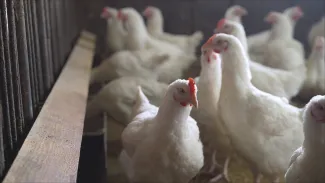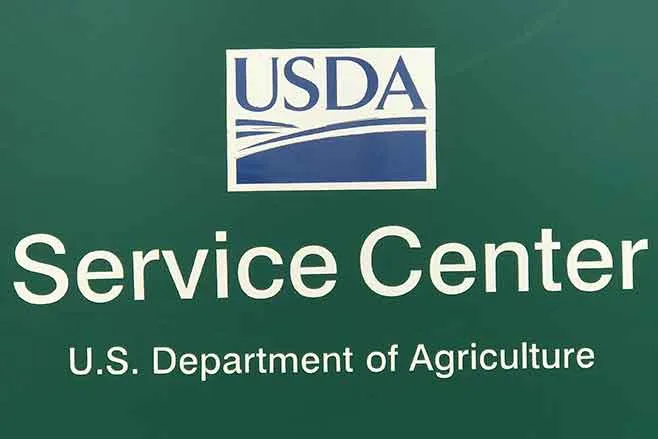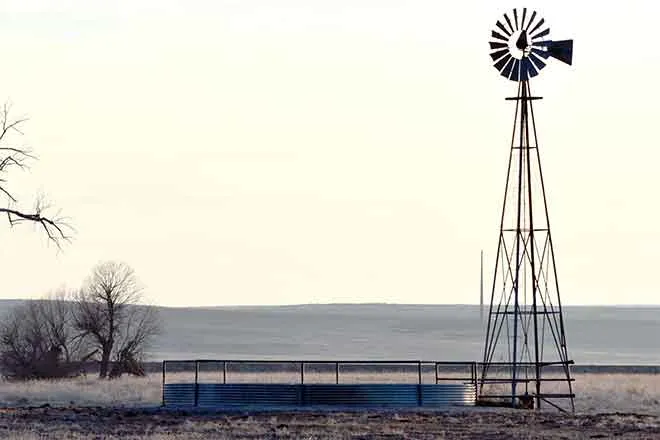
Proposal aims to beef up ag worker protections in Nebraska, lower egg costs
Wikimedia
Nebraska lawmakers are considering a measure to beef up protections for meatpacking and poultry workers and ensure emergency plans in situations such as bird flu outbreaks.
Legislative Bill 573, which requires certain ag operations to implement disaster mitigation plans for workers and the food supply, should fortify the state’s economic backbone, said sponsoring State Senator Dunixi Guereca of Omaha.
It calls for full workers’ compensation for injuries during crises such as animal disease outbreaks or weather calamities.
And for omelette lovers, the bill might even lighten the toll at the neighborhood diner.

Egg prices have fluctuated wildly because of the bird flu or avian influenza. A customer walks by a display of fresh eggs at a grocery store on September 25, 2024. (Photo by Justin Sullivan/Getty Images)
“My constituents are sick of the rising cost of eggs and ask what I can do to help alleviate the costs,’” Guereca said during a public hearing on the bill Monday. “My theory is that if we protect the workforce and (food) supply chain, we can eventually restore access to affordable eggs.”
Bird flu, superbugs
Guereca said the “re-emergence of bird flu and other superbugs” amplifies the need for lawmakers to consider what he sees as a “proactive” Meat and Poultry Workers and Contract Growers Protection Act.
So far in Nebraska this year, the highly contagious avian influenza, or bird flu, has been confirmed in three flocks. The deadly flu can force the slaughter of birds, with the loss of laying hens leading to rising egg prices.
Bird flu in humans
Nationally, 70 human cases of bird flu and one death have been confirmed since 2024. Most cases of bird flu associated with the ongoing outbreak in the U.S. have resulted in mild symptoms in people. Severity of illness can be impacted by factors including genetic changes in the virus and the amount of virus to which the infected people were exposed, according to the Centers for Disease, Control and Prevention.

© Ruslan Sidorov - iStock-1197330374
He said he had Lincoln Premium Poultry of Fremont in mind when he included contract growers. The largest poultry operation in Nebraska, formed to produce chickens for Costco, includes 1,200 employees and about 100 family farms under contract to grow the chickens.
Monday, the Legislature’s Business and Labor Committee heard from a half-dozen proponents of the bill, including a homeowner who lives near a poultry operation, a Grand Island landlord and an epidemiologist.
Jessica Kolterman, director of administration for Lincoln Premium Poultry, was one of two opponents to testify.
Kolterman told committee members that her company already has emergency plans in place, and that protocol for situations such as avian influenza are controlled and guided generally by the U.S. and Nebraska Departments of Agriculture.
Disaster mitigation plans under the bill would require a description of potential disaster events that affect animals, and a plan to ensure the animals have food, water and shelter during extreme weather events. The plan must address how to dispose of dead animals and provide protective worker equipment and other safeguards addressing public health threats.
“We believe we are prepared,” she said.“ We support the intent of keeping workers safe, but not the legislation.”
Bill highlights
Among other highlights of LB 573:
- Creation of a state task force to monitor practices.
- At least two years of health care for covered workers impacted by a disaster event.
- At least 12 weeks of severance pay for covered workers and six months of lost wages for workers impacted by disasters.
Ryan McIntosh, representing the National Federation of Independent Business and Nebraskans for Workers’ Compensation and Equity and Fairness, objected to the provision he said would extend workers’ compensation coverage for two years to non-employees.
“That is a huge change in the history of workers’ compensation and unprecedented,” he said. “That would have an effect on workers comp premiums for employers of all sizes all across the state.”
Said McIntosh: “It’s one thing to require mitigation disaster planning. It’s quite another to add these significant changes in liability being shifted onto businesses that don’t even employ some of these individuals.”
Questions by lawmakers
State Senator Tony Sorrentino of Omaha, a member of the committee, said he wanted more information about what the legislation might cost employers.
State Senator Teresa Ibach of Sumner, in questioning Guereca, said she believed some components of the bill already were in place, such as the call for employers to have a plan for dead animal disposal.

© iStock - wellesenterprises
Guereca — picking up the efforts of predecessor former State Senator Tony Vargas, who also sought worker protection legislation — said he would do further investigation on that point, but said the bill was designed holistically to strengthen the industry.
Among those who voiced support for the bill was Edison McDonald of GC Resolve, which advocates for family farmers and impact on communities. McDonald said recent outbreaks of avian flu have increased volatility in commodity prices. He said, for example, egg prices have increased about 38 percent nationally since January.
He believes the planning and response mechanisms called for under the bill would help manage outbreaks and disruption of the food supply chain.
Robert Wallace, an evolutionary epidemiologist, said committee members might wonder why a public health professional who studies diseases would care so much about agriculture.
He said most new infections today are emerging out of agricultural practices, livestock and poultry. Hence, said Wallace, better protection of meatpackers and contractors who take care of animals should lead to less risk to the broader population.
“Whether or not a new pathogen emerges from inside Nebraska, the provisions of this bill will, in the course of protecting farmers and meatpackers, help protect the whole of the state of Nebraska,” he said.
Penalties, state costs
A legislative fiscal analysis said 26 Nebraska agribusinesses currently meet the definition of a “covered industrial operator” under LB 573 — meatpackers and slaughterhouses with over 250 employees.
The bill would require those operators to implement the guidelines and cover affected workers. The Nebraska Department of Labor would monitor compliance and could assess civil penalties of up to $15,000 against an operator violating the law.
The fiscal analysis projects the cost to be about $815,000 in the first year, largely for six employees to administer the Act, including three bilingual labor law specialties.
Of those who submitted written comments on the bill, 30 were supporters and five were opponents, according to committee chair State Senator Kathleen Kauth of Omaha.
The committee did not take action on whether to advance the bill to the full Legislature.

















